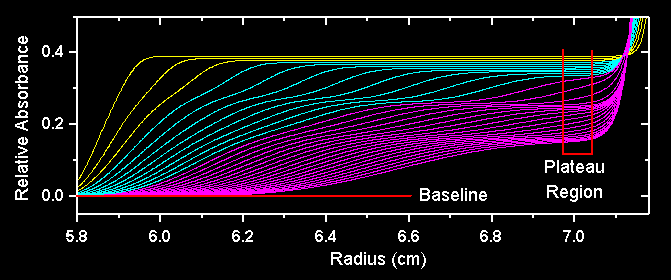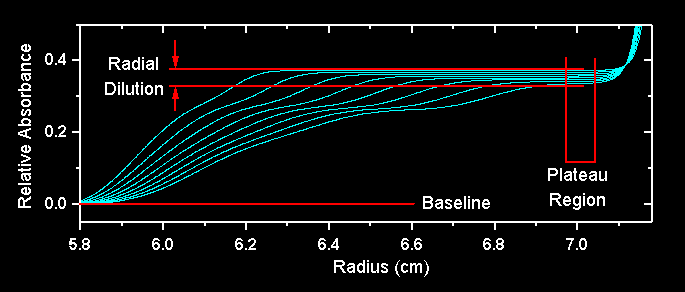van Holde - Weischet Tutorial |
The van Holde - Weischet analysis is based on a solution of the Lamm equation which assumes an infinitely long cell. This solution does not consider the exisiting boundary conditions, the meniscus and the bottom of the cell. In an infinitely long cell, material never pellets. In addition, in an infinitely long cell there will never be any back-diffusion from the bottom of the cell. Both pelleting and back-diffusion occurs because material accumulates at the bottom of the cell. Since these boundary conditions are not considered in the solution of the Lamm equation employed by the van Holde- Weischet analysis, all data scans that contain absorption profiles resulting from boundary effects will distort the solution.
Thus, all data included in the van Holde - Weischet analysis needs to be free of boundary effects. Therefore, you need to exclude any data containing boundary effects during editing or at runtime. Another requirement is that all scans included in the data analysis represent the same chemical composition of the sample(s) contained in the system. This is very important because the analysis attempts a global fit including all data in the extrapolation to infinite time. If the scans included in the analysis represent different compositions (for example, time dependent aggregation or degradation), the extrapolations will be misleading, although some diagnostic indicator can usually be obtained for such cases from the van Holde - Weischet extrapolation plot (please see the section on diagnostics for more information on indicators and analysis complications).
The following section explores which scans can be included in the analysis and which scans should be excluded.

Figure 10:This figure shows a heterogeneous system of scans, outlined in 3 different colors. Only scans outlined in blue should be included in the analysis.

Figure 11:The scans shown below are appropriate for inclusion in the van Holde - Weischet analysis since they meet all necessary criteria, such as baseline and stable plateau.
Please consider the following points when selecting the baseline and plateau region:
The UltraScan software will guide you during editing to define these points and automatically averages the points.
Speed Selection:
Attempt to select a speed as fast as possible with the shortest intervals between scans, such that the boundary transverses approximately 2/3 of the cell with at least 15-20 scans. The faster the sample is spun, the less time it has to diffuse, and the more pronounced will be the difference between multiple components and the resolution of the analysis. Please review the section on experimental design for more information on optimal experimental setup.
Summary:
 |
 |
 |
This document is part of the UltraScan Software Documentation distribution.
Copyright 1998, 1999, The University of Texas Health Science Center at San Antonio.
The latest version of this document can always be found at:
Last modified on June 12, 1999.